Oracle 11g必须开启的服务及服务详细介绍
- 格式:doc
- 大小:118.50 KB
- 文档页数:2

一、服务1、Oracle服务有很多,最重要的有两个:OracleOraDb11g_home1TNSListener和OracleServiceORCL。
2、由于服务众多,如果全部默认自动启动的话会导致开机非常的缓慢,而且有些服务并不是经常或者必须要用,可以改为手动启动以缓解开机压力。
3、OracleServiceORCL服务是oracle的主服务比较大而且最好设为自动启动。
4、OracleOraDb11g_home1TNSListener服务是oracle的监听服务也是必须开启的。
5、监听服务很容易出错,主要在于两方面:注册表的误操作和网络环境的变更。
6、注册表误操作主要指的是使用系统优化软件,优化软件将注册表清空,导致服务无法开启。
7、网络环境的变更主要指的是计算机名的改变,在oracle 10g之前在修改主机名生效后,监听五服务就会无法正常启动(11g以后会自动识别)。
这种时候就需要进行手动配置了,修改listener.ora和s=tnsnames.ora两个配置文件,将文件中的HOST=[原主机名]修改成现主机名即可。
8、需要外部程序访问数据库的时候要进行网络管理配置,打开Oracle自带的Oracle Net Manager软件可进行设置,Oracle Net设置->本地->监听程序->数据库服务->添加数据库然后修改数据库的全局数据库名和SID即可(需与本地数据库同名?)二、工具1、数据库操作的命令用sqlplus完成,sqlplus的两种形式:sqlplus.exe纯命令行模式和sqlplus w带窗口的操作环境(较为常用)。
2、在登录的时候可以选择主机字符串,在sqlplus命令行操作中是默认选择为空。
当有多个数据库的时候,就要选择相应的数据库的主机字符串(即数该数据库名称)。
3、在sqlplus中操作数据库既可以直接敲响应命令直接执行,也可以使用ed和@来执行命令。

ORACLE DATABASE MOBILE SERVER ® 11g Oracle Database Mobile Server 11g is the best way to securely connect embedded devices and mobile applications to Oracle Database. Any organization with a mobile workforce or network of remote devices can benefit from using Oracle Database Mobile Server to safely and reliably link them into their existing enterprise infrastructure. Oracle Database Mobile Server is designed to work with Berkeley DB, Oracle’s high performance mobile data store. It is also compatible with SQLite, the popular open source project. Oracle Database Mobile Server Overview Oracle Database Mobile Server 11g is a reliable, secure way to link mobile applications and embedded devices into existing enterprise infrastructure. It is well suited for mission critical applications or any application where high performance and reliability are required. It extends the application grid to mobile devices, allowing access to enterprise data and applications in the absence of a network connection. When a network connection is available, Oracle Database Mobile Server uses data synchronization to allow reliable and secure data exchange with a backend Oracle Database. The three main components of Oracle Database Mobile Server are: 1) Mobile Client, resides on mobile platform to facilitate sync and remote management 2) The Sync Server itself, coupled with the Mobile Manager console, provide scalable, secure management of data, applications and devices. 3) Mobile Development Kit (MDK), a suite of tools for packaging, publishing and testing applications. Multi-Platform Mobile Client Oracle Database Mobile Server supports many different client platforms, including Java, Android, Blackberry, Windows Desktop & Mobile, and Linux. The Mobile Client provides support for either a SQLite database or Oracle Berkeley DB. • Berkeley DB is a widely deployed, mature embedded database library that provides enterprise class features, including high throughput, low-latency reads, non-blocking writes, data scalability and in-memory caching in a small memory footprint. Berkeley DB offers a SQL API that is SQLite compatible. Berkeley DB offers features that allow it to scale well beyond the limitations of the SQLite native library, while retaining the ease-of-use of the SQLite API. • SQLite is a very popular open source embedded database library and is widely used in smart phones, including Android and Blackberry devices. It is a small footprint, transactional database library that is self-administering, requiring no external DBA. The Mobile Client supports both databases with a rich set of data synchronization features. Data synchronization can be enabled in a variety of ways – automatic background sync, manual sync using a GUI, command line app, or even from another application using API calls.A device agent on the Mobile client allows administrators to remotely manage the device by sending commands or querying the system. Application life-cycle management can be achieved by enabling remote application updates.Enterprise Ready Mobile ServerAt the core of the Oracle Database Mobile Server product is the server itself, which can be deployed on commodity server hardware running industry standard operating systems including Windows, Linux, Solaris, HP-UX and IBM AIX. The Mobile Server provides a reliable, bi-directional synchronization system and a powerful administration interface.Robust and Scalable Synchronization SystemBased on the publish/subscribe or “pub-sub” model, the Oracle Database Mobile Server synchronization system allows efficient asynchronous and synchronous incremental data synchronization between thousands of mobile users and the Oracle Database.Oracle Database Mobile Server features a robust and resilient synchronization process. In the event of a network failure, the client will resume the function from the last acknowledged checkpoint rather than restart the transmission. The result is that a successful synchronization can be achieved even over unreliable network connections.Oracle Database Mobile Server is capable of analyzing information contained in the mobile application to automatically create the application's server-side synchronization logic. It provides a flexible architecture that enables customization of the synchronization process at multiple levels. Callback support enables interleaving various application-specific tasks during the various synchronization phases. Developers can choose to optimize only the resource intensive Compose phase of synchronization by implementing java classes that leverage their insights into the data model. Alternatively, developers can provide full control of the synchronization system by independently managing the data queues that contain the uploaded data and the client updates to be downloaded.Conflicts can occur when the same data has been modified by the server and the client, or by multiple clients. Oracle Database Mobile Server automatically detects such conflicts and resolves them based on a highly customizable rule set.Comprehensive Management and AdministrationOracle Database Mobile Server employs a secure, centralized repository to support a unified interface for distributing and managing software and data on remote systems. Mobile Manager, a web-based administration interface for Mobile Server, enables 100% server-side management of all mobile applications, devices, users and mobile servers. The administrator can create users and groups, assign application access privileges, send device commands and retrieve device diagnostic information from a single interface. Integration with enterprise Oracle OID and LDAP directories further simplifies user management. In addition, the administrator can manage the synchronization process by setting its frequency, resolving errors, or analyzing and tuning its performance from the same interface. A scripting language is available that can be used to batch administration functions minimize administrator overhead.Rapid Application Development SupportThe Mobile Development Kit (MDK) is included with Oracle Database Mobile Server. It consists of a set of tools, APIs, tutorials and code samples that accelerate the development of mobile applications.The main component of the MDK is the Mobile Database Workbench (MDW), a visual development tool for designing synchronized databases. Wizards in the MDW accelerate creation of synchronized databases by allowing developers to quickly define and customize snapshots of enterprise data models for incorporation into these databases. The Packaging Wizard enables bundling all application components (executables, libraries, images, help files etc.) into a JAR file for simple upload to the Mobile Server from where it can be deployed to mobile, embedded or lightweight business environments easily.Developers can use Oracle JDeveloper with ADF Mobile to visually develop applications that enable access to critical business data. Oracle Database Mobile Server includes support for deploying and managing applications created using JDeveloper and ADF Mobile.Oracle Database Mobile Server also supports familiar data access interfaces and open standards such as ODBC, JDBC, and . Tutorials and samples included in the documentation and MDK install highlight how to leverage specific features or develop applications on a particular platform.Table 1 Supported client platformsHigh Performance and ScalabilityOracle Database Mobile Server delivers impressive out-of-the-box performance, enabling users to access information quickly and efficiently. Support for multiprocessor systems and dynamic cache sizing ensure top performance for larger databases and greater numbers of connected users. Oracle Database Mobile Server provides tools to tune the performance of data synchronization.Oracle Database Mobile Server integrates with Oracle WebLogic Server to enable scaling of Mobile Server deployments by taking advantage of the load balancing features.On the mobile device side, Berkeley DB’s small footprint, extreme scalability, and fine-grain locking make it suitable for almost any application. It supports a high degree of concurrency, including support for concurrent Vacuum and Backup commands.Unparalleled Device and Application SecurityOracle Database Mobile Server provides standard device commands as well as the infrastructure to implement customized commands to support enterprise business processes and security best practices. For example, you can issue commands to synchronize the database, perform diagnostics, or change application settings. In the event of a device loss, theft, or other security concern, you can delete applications and databases, uninstall the client or reset the password. SSL based encryption protects data integrity while data is in transit between the device and the enterprise database.JavaN/A Yes N/A AndroidN/A Yes N/A BlackberryN/A Yes N/A Windows Desktopand MobileYes Yes Yes Linux Yes Yes N/ATable 2 Key Oracle Database Mobile Server featuresConclusionOrganizations of all types can leverage Oracle Database Mobile Server 11g to increase employee productivity, reduce operation costs, and improve customer satisfaction. Oracle Database Mobile Server has delivered demonstrable impact in a wide variety of roles, including sales force automation, data collection, customer relationship management (CRM), and field service applications. It has an established presence in a range of industries including financial services, healthcare, transportation, logistics, government, retail, military, and law enforcement. It is also commonly used as a building block for custom solutions by ISVs and System Integrators (SIs).Contact UsFor more information about Oracle Database Mobile Server, please visit or call +1.800.ORACLE1 to speak to an Oracle representative.Oracle is committed to developing practices and products that help protect the environmentCopyright © 2011, Oracle and/or its affiliates. All rights reserved.This document is provided for information purposes only and the contents hereof are subject to change without notice. This document is not warranted to be error-free, nor subject to any other warranties or conditions, whether expressed orally or implied in law, including implied warranties and conditions of merchantability or fitness for a particular purpose. We specifically disclaim any liability with respect to this document and no contractual obligations are formed either directly or indirectly by this document. This document may not be reproduced or transmitted in any form or by any means, electronic or mechanical, for any purpose, without our prior written permission.Oracle is a registered trademark of Oracle Corporation and/or its affiliates. Other names may be trademarks of their respective owners.• Footprint is 1 MB• Very broad platform support• High performance• Non-blocking writes• In-memory caching• Concurrent access bymultiple threads orprocesses• Full ACID transactions• Automatic recovery• Scales to TB of data ina single table• JDBC, ODBC, APIs• SQL API compatiblewith SQLite, SQL-92• 128-bit AES encryption • Fine-grain locking• Zero administration • Flexible & reliable bi- directional synchronization • Asynchronous architecture for high scalability • Multi-threaded architecture • Custom synchronization invocation • Automatic (background) Synchronization • Support for schema evolution • SSL encryption & data compression • Network failure recovery • Built-in and custom conflict detection / resolution • Ability to synchronize data and applications• EM compliant UI • Single Sign-On capability using Oracle Identity Management • Scripting language for batch administration • Extension APIs • User management • Application provisioning and deployment • Device management including remote diagnostics • Unified interface to monitor synchronization and resolve errors。
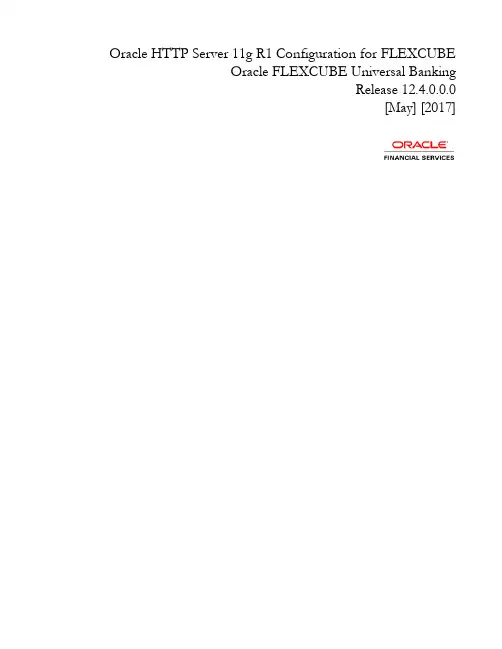
Oracle HTTP Server 11g R1 Configuration for FLEXCUBEOracle FLEXCUBE Universal BankingRelease 12.4.0.0.0[May] [2017]Table of Contents1.PURPOSE (3)2.INTRODUCTION TO ORACLE HTTP SERVER (OHS) (3)2.1HTTP L ISTENER (3)2.2M ODULES (MODS) (3)3.INSTALLATION OF OHS 11G (4)4.CONFIGURE ORACLE HTTP SERVER INFRONT OF WEBLOGIC SERVER (11)4.1F OR W EB L OGIC IN SINGLE INSTANCE (11)4.2F OR W EBLOGIC INSTANCES IN CLUSTER (12)5.ENABLE “WEBLOGIC PLU G-IN ENABLED” FLAG I N WEBLOGIC (13)PRESSION RULE SETTING (13)6.1L OADING MOD_DEFLATE (13)6.2C ONFIGURING FILE TYPES (14)6.3HTTPD.CONF FILE CHANGES (14)7.CONFIGURING SSL FOR ORACLE HTTP SERVER (16)7.1SSL CONFIGURATION FOR I NBOUND R EQUEST TO O RACLE HTTP S ERVER (16)7.1.1Create a new Wallet and import Certificate (16)7.1.2Configuring Wallet in ssl.conf file (20)7.2C ONFIGURING SSL BETWEEN O RACLE HTTP S ERVER AND O RACLE W EBLOGIC S ERVER (21)7.2.1Turn off KeepAliveEnabled (21)7.2.2To enable one-way SSL (21)7.2.3To enable two-way SSL (22)8.SAMPLE CONFIGURATION FILES (23)9.STARTING, STOPPING, AND RESTARTING ORACLE HTTP SERVER (23)9.1S TART (23)9.2S TOP (23)9.3R ESTART (23)10.TEST THE APPLICATION (24)11.SERVER LOGS LOCATION (24)12.REFERENCES (24)1. PurposeThe objective of this document is to explain the installation and configuration of Oracle HTTP Server 11g R1(11.1.1.6.0). This includes setting up of server details, configuration of compression rules and enabling SSL.2. Introduction to Oracle HTTP Server (OHS)Oracle HTTP Server is the Web server component for Oracle Fusion Middleware. It is based on Apache web server, and includes all base Apache modules and modules developed specifically by Oracle. It provides a HTTP listener for Oracle WebLogic Server and the framework for hosting static pages, dynamic pages, and applications over the Web. Key aspects of Oracle HTTP Server are its technology, its serving of both static and dynamic content and its integration with both Oracle and non-Oracle products.Oracle HTTP Server consists of several components that run within the same process. These components provide the extensive list of features that Oracle HTTP Server offers when handling client requests.Following are the major components:2.1 HTTP ListenerOracle HTTP Server is based on an Apache HTTP listener to serve client requests. An HTTP server listener handles incoming requests and routes them to the appropriate processing utility.2.2 Modules (mods)Modules extend the basic functionality of Oracle HTTP Server, and support integration between Oracle HTTP Server and other Oracle Fusion Middleware components. There are modules developed specifically by Oracle for Oracle HTTP Server. Ex: mod_wl_ohs, mod_plsqlOracle HTTP Server also includes the base Apache and third-party modules out-of-the-box.These modules are not developed by Oracle. Ex: mod_proxy, mod_perl3. Installation of OHS 11gInvoke the setup exe to start the installationSelect Skip Software UpdatesSelect Install and ConfigureSelect only Oracle HTTP ServerEnter the required OHS instance and component namesThis completes the installation of Oracle HTTP Server with <Instance> and <component>. Example: Instance is instance1 and component is ohs1.If you would like to change the port after the installation(OHS Listen Port) edit$ORACLE_INSTANCE/config/OHS/<component_name>/httpd.conf and change the listen port.NOTE: This port is for http protocol and not for https.4. Configure Oracle HTTP Server infront of Weblogic ServerIn Oracle HTTP Server requests from Oracle HTTP Server to Weblogic server are proxied usingmod_wl_ohs module. This configuration file needs to be modified to include the Weblogic server and port details.mod_wl_ohs.conf file is located at${ORACLE_INSTANCE}/config/OHS/{COMPONENT_NAME}/mod_wl_ohs.confAdd the below directives to mod_wl_ohs.conf file.4.1 For WebLogic in single instance<Location /<<context/url>> >SetHandler weblogic-handlerWebLogicHost <<server name>>WeblogicPort <<port>></Location>Example:<Location /FCJNeoWeb>SetHandler weblogic-handlerWebLogicHost wlserver1WeblogicPort 7707</Location>This will forward /FCJNeoWeb from HTTP server to /FCJNeoWeb on WebLogic Server wlserver1: 77074.2 For Weblogic instances in cluster<Location /<<context/url>> >SetHandler weblogic-handlerWebLogicCluster <server1>:<port1>,<server2>:<port2></Location>Example<Location / FCJNeoWeb >SetHandler weblogic-handlerWebLogicCluster wlserver1:7010, wlserver2:7010</Location>This will forward /FCJNeoWeb from HTTP server to /FCJNeoWeb on WebLogic Cluster wlserver1:7010 and wlserver2:70105.Enable “WebLogic Plug-In Enabled” flag in weblogicThis flag needs to be enabled in weblogic if it is accessed through proxy plugins. When the WebLogic plugin is enabled, a call to getRemoteAddr will return the address of the browser client from the proprietary WL-Proxy-Client-IP header instead of the web server.a. Plugin flag at managed server leveli. Click on ‘Environment’- > 'Servers' -> '<ManagedServer>' -> 'General' -> 'Advanced'ii. Check the 'WebLogic Plug-In Enabled' box.iii. Click 'Save'iv. Restart the Server.b. Plugin flag at domain levelv. Click on <Domain> -> 'Web Applications'vi. Check the 'WebLogic Plug-In Enabled' box.vii. Click 'Save'viii. Restart the server.6. Compression rule settingContent compression in Oracle HTTP Server is done using mod_deflate. This can compress HTML, text or XML files to approx. 20 - 30% of their original sizes, thus saving on server traffic. However, compressing files causes a slightly higher load on the server, but clients' connection times to server is reduced.6.1 Loading mod_deflatemod_deflate is used for compression in OHS and this is installed in Oracle HTTP Server under location "${ORACLE_HOME}/OHS/modules/mod_deflate.so"But it might not be loaded.To load the file add the below directive in mod_wl_ohs.conf fileLoadModule deflate_module "${ORACLE_HOME}/OHS/modules/mod_deflate.so"6.2 Configuring file typesmod_deflate also requires to specify which type files are going to be compressed.In the LOCATION section of mod_wl_ohs.conf file add the below entries.AddOutputFilterByType DEFLATE text/plainAddOutputFilterByType DEFLATE text/xmlAddOutputFilterByType DEFLATE application/xhtml+xmlAddOutputFilterByType DEFLATE text/cssAddOutputFilterByType DEFLATE application/xmlAddOutputFilterByType DEFLATE application/x-javascriptAddOutputFilterByType DEFLATE text/htmlSetOutputFilter DEFLATEImages are supposed to be in a compressed format, and therefore are bypassed by mod_deflate.6.3 httpd.conf file changesThis is a server configuration file which typically contains directives that affect how the server runs, such as user and group IDs it should use, and location of other files. Cross check the existence of mod_wl_ohs.conf include in httpd.conf file.httpd.conf file is present under location“${ORACLE_INSTANCE}/config/OHS/{COMPONENT_NAME}/httpd.conf”In this file cross check for the below entryinclude "${ORACLE_INSTANCE}/config/OHS/${COMPONENT_NAME}/mod_wl_ohs.conf"If above include entry is not present, then add the above include section.7. Configuring SSL for Oracle HTTP ServerSecure Sockets Layer (SSL) is required to run any Web site securely. Secure Sockets Layer (SSL) is an encrypted communication protocol that is designed to securely send messages across the Internet.Reading of “SSL_Configuration on Weblogic” document provide d as part of FCUBS installation isrecommended before proceeding with further setup.In Oracle HTTP server, SSL configuration can be done between1. Browser to Oracle HTTP Server(Mandatory)2. Oracle HTTP Server to Oracle Weblogic Server(If required)7.1 SSL configuration for Inbound Request to Oracle HTTP ServerPerform these tasks to enable and configure SSL between browser and Oracle HTTP Server.1. Obtain a certificate from CA or create a self signed certificate.2. Create an Oracle Wallet which contains the above SSL Certificate. The default wallet that isautomatically installed with Oracle HTTP Server is for testing purposes only. The default wallet is located in "${ORACLE_INSTANCE}/config/OHS/${COMPONENT_NAME}/keystores/default"3. Configuring Wallet in ssl.conf file7.1.1 Create a new Wallet and import Certificate1. Go to the \Oracle_WT1\bin\launch.exe, this will launch your wallet manager2. Click on Create new and then click no option.3. Enter the wallet password and click on OK, this will create a new wallet.4. Not it will ask for certificate request creation, Click on NO to proceed5. Right click on trusted certificates and then import trusted certificate.6. Browse to the folder where certificate is stored and click on Open7. Click on Save Wallet button on the left side navigation and save the wallet either to defaultlocation("${ORACLE_INSTANCE}/config/OHS/${COMPONENT_NAME}/keystores/default") or folder of your choice.8. Click on Wallet tab and enable Auto Login7.1.2 Configuring Wallet in ssl.conf fileIn ssl.conf file the newly created wallet need to updated. This file is located under folder"${ORACLE_INSTANCE}/config/OHS/${COMPONENT_NAME}/1. Change the SSLWallet directive to point to the location of new wallet created.SSLWallet "${ORACLE_INSTANCE}/config/${COMPONENT_TYPE}/${COMPONENT_NAME}/keystores/"2. Change the Listen port number in ssl.conf file to the SSL enabled port, by default the value is 44437.2 Configuring SSL between Oracle HTTP Server and Oracle Weblogic ServerSSL for outbound requests from Oracle HTTP Server are configured in mod_wl_ohs.Refer to “SSL_Configura tion on Weblogic” document for weblogic server setting mentioned in below section.7.2.1 Turn off KeepAliveEnabledThe below parameter in mod_wl_ohs should be turned off, by default it is on. Add the below directive under LOCATION section of mod_wl_ohs fileKeepAliveEnabled OFF7.2.2 To enable one-way SSL1. Generate a custom keystore identity.jks for Weblogic Server containing a certificate.2. At Identity section in Keystores tab in weblogic Admin Console for server seta. The custom trust store with the identity.jks file locationb. The keystore type as JKSc. The passphrase used to created the keystore3. Copy the certificate to Oracle HTTP Server and import the new certificate into OHS wallet as a trustedcertificate.4. Add following new directive in mod_wl_ohs.conf to point to the wallet locationWlSSLWallet "${ORACLE_INSTANCE}/config/OHS/{COMPONENT_NAME}/keystores/default"5. Change the port in mod_wl_ohs file to point to SSL port of Weblogic server.6. Restart both Weblogic Server and Oracle HTTP Server7.2.3 To enable two-way SSL1. Perform one-way SSL configuration steps2. Generate a new trust store, trust.jks for Weblogic server3. Keystore created for one-way SSL could be used, but it is recommended to create a separate truststore4. Export the user certificate from Oracle HTTP Server wallet, and import it into truststore created above5. At Trust section in Keystores tab in Weblogic Admin Console for the server seta. The custom trust store with the trust.jks file locationb. The keystore type as JKSc. The passphrase used to created the keystore6. Under the SSL tabEnsure trusted CA is set as from Custom Trust Keystore.7. Restart Weblogic Server8. Sample Configuration Fileshttpd.conf mod_wl_ohs.conf ssl.conf9. Starting, Stopping, and Restarting Oracle HTTP ServerNavigate to the below location in command prompt ${ORACLE_INSTANCE}/bin/ and run below commands 9.1 Startopmnctl startproc ias-component={COMPONENT_NAME}Example: opmnctl startproc ias-component=ohs19.2 Stopopmnctl stopproc ias-component={COMPONENT_NAME}Example: opmnctl stopproc ias-component=ohs19.3 Restartopmnctl restartproc ias-component={COMPONENT_NAME}Example: opmnctl restartproc ias-component=ohs110. Test the applicationTest the application deployed on Weblogic using Oracle HTTP Server after restarting both the oracle http server and weblogic serverhttps://ohs_servername:ohs_https_port/<<context/url>>http://ohs_servername:ohs_http_port/<<context/url>>ohs_servername: server on which OHS is deployedohs_https_port: port number mentioned against LISTEN directive in SSL.conf fileohs_http_port: port number mentioned against LISTEN directive in httpd.conf fileExample:https://localhost:4443/FCJNeoWeb/welcome.jspOrhttp://localhost:7777/FCJNeoWeb/welcome.jsp11. Server Logs LocationOracle HTTP Server Logs are generated under folder${ORACLE_INSTANCE}/diagnostics/logs/OHS/{COMPONENT_NAME}/12. ReferencesSSL_Configuration.doc for Weblogic provided as part of FCUBS installation./cd/E16764_01/web.1111/e10144/under_mods.htm/cd/E25054_01/core.1111/e10105/sslconfig.htmOracle_HTTP_Server_Configuration[May] [2017]Version 12.4.0.0.0Oracle Financial Services Software LimitedOracle ParkOff Western Express HighwayGoregaon (East)Mumbai, Maharashtra 400 063IndiaWorldwide Inquiries:Phone: +91 22 6718 3000Fax:+91 22 6718 3001/financialservices/Copyright © 2007, 2017, Oracle and/or its affiliates. All rights reserved.Oracle and Java are registered trademarks of Oracle and/or its affiliates. Other names may be trademarks of their respective owners. U.S. GOVERNMENT END USERS: Oracle programs, including any operating system, integrated software, any programs installed on the hardware, and/or documentation, delivered to U.S. Government end users are "commercial computer software" pursuant to the applicable Federal Acquisition Regulation and agency-specific supplemental regulations. As such, use, duplication, disclosure, modification, and adaptation of the programs, including any operating system, integrated software, any programs installed on the hardware, and/or documentation, shall be subject to license terms and license restrictions applicable to the programs. No other rights are granted to the U.S. Government.This software or hardware is developed for general use in a variety of information management applications. It is not developed or intended for use in any inherently dangerous applications, including applications that may create a risk of personal injury. If you use this software or hardware in dangerous applications, then you shall be responsible to take all appropriate failsafe, backup, redundancy, and other measures to ensure its safe use. Oracle Corporation and its affiliates disclaim any liability for any damages caused by use of this software or hardware in dangerous applications.This software and related documentation are provided under a license agreement containing restrictions on use and disclosure and are protected by intellectual property laws. Except as expressly permitted in your license agreement or allowed by law, you may not use, copy, reproduce, translate, broadcast, modify, license, transmit, distribute, exhibit, perform, publish or display any part, in any form, or by any means. Reverse engineering, disassembly, or decompilation of this software, unless required by law for interoperability, is prohibited.The information contained herein is subject to change without notice and is not warranted to be error-free. If you find any errors, please report them to us in writing.This software or hardware and documentation may provide access to or information on content, products and services from third parties. Oracle Corporation and its affiliates are not responsible for and expressly disclaim all warranties of any kind with respect to third-party content, products, and services. Oracle Corporation and its affiliates will not be responsible for any loss, costs, or damages incurred due to your access to or use of third-party content, products, or services.。
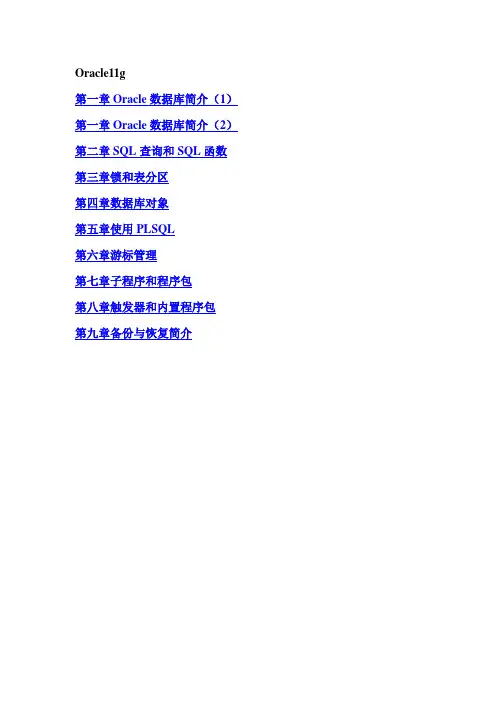
Oracle11g第一章Oracle数据库简介(1)第一章Oracle数据库简介(2)第二章SQL查询和SQL函数第三章锁和表分区第四章数据库对象第五章使用PLSQL第六章游标管理第七章子程序和程序包第八章触发器和内置程序包第九章备份与恢复简介第一章Oracle数据库简介(1)一、了解Oracle数据库思路:基础架构——Sql语句——PL/SQL——存储过程包。
二、Oracle数据库体系结构的各种组件:物理组件和逻辑组件。
三、Oracle数据库是对象关系型数据库管理系统(ORDBMS):在数据安全性和数据完整性控制方面性能优越;跨操作系统,跨硬件平台的数据互操作能力。
四、Oracle数据库的主要特点:支持多用户,大事务量的事务处理;数据安全性和完整性控制;支持分布式数据处理;可移植性。
五、数据库的体系结构是指数据库的组成、工作过程与原理,以及数据在数据库中的组织与管理机制。
Oracle实例六、Oracle数据库实例:七、数据库基本组件:八、使用Oracle数据库开发工具:第一步:需要启动Oracle核心服务引擎:Oracleservice+SID :SID是指在安装过程中指定数据库的全局数据库名称;如:Oracleserviceaccp,(注:点之前的名称长度不能超过8个)。
第二步:启动监听服务器:1、OEM企业管理启动:进入之后:如果有其他,就移除再添加,弹出的窗口设置:然后,建立连接,进行用户登录:先登录:sys/sys AS SYSDBA进行授予scott/tiger 用户于DBA权限;在安全性用户里授权:DBA权限接着点击应用,断开连接,重新连接服务器,启动scott/tiger普通用户:可以看到配置信息方案里面有用户方案,方案里有数据表结构和其他信息:可以创表建约束2、sqlplus GUI版:进入之后:或者:进入之后的窗口:3、sqlplus CMD版:在dos命令下编辑:改变用户:接着就可以增删改查。
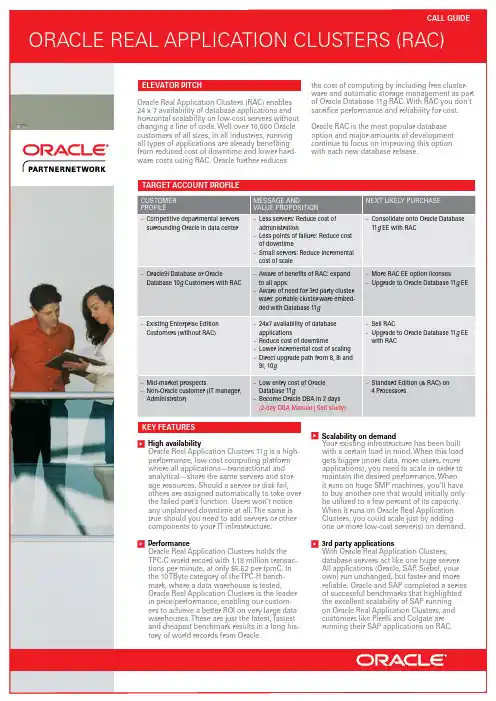
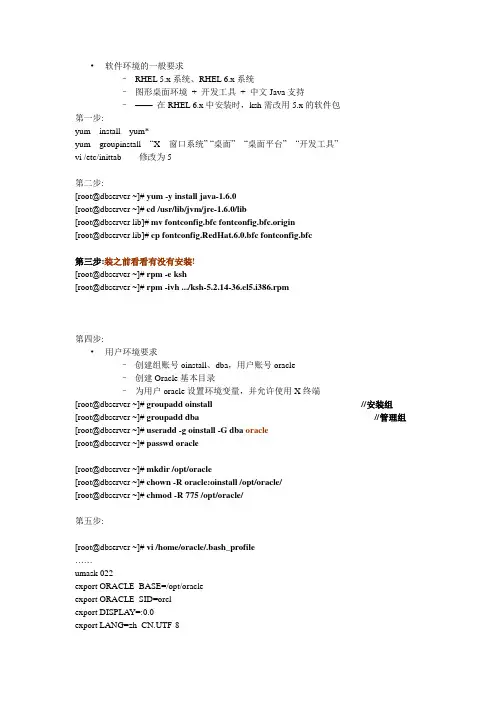
•软件环境的一般要求–RHEL 5.x系统、RHEL 6.x系统–图形桌面环境+ 开发工具+ 中文Java支持–——在RHEL 6.x中安装时,ksh需改用5.x的软件包第一步:yum install yum*yum groupinstall “X 窗口系统”“桌面”“桌面平台”“开发工具”vi /etc/inittab 修改为5第二步:[root@dbserver ~]# yum -y install java-1.6.0[root@dbserver ~]# cd /usr/lib/jvm/jre-1.6.0/lib[root@dbserver lib]# mv fontconfig.bfc fontconfig.bfc.origin[root@dbserver lib]# cp fontconfig.RedHat.6.0.bfc fontconfig.bfc第三步:装之前看看有没有安装![root@dbserver ~]# rpm -e ksh[root@dbserver ~]# rpm -ivh .../ksh-5.2.14-36.el5.i386.rpm第四步:•用户环境要求–创建组账号oinstall、dba,用户账号oracle–创建Oracle基本目录–为用户oracle设置环境变量,并允许使用X终端[root@dbserver ~]# groupadd oinstall //安装组[root@dbserver ~]# groupadd dba //管理组[root@dbserver ~]# useradd -g oinstall -G dba oracle[root@dbserver ~]# passwd oracle[root@dbserver ~]# mkdir /opt/oracle[root@dbserver ~]# chown -R oracle:oinstall /opt/oracle/[root@dbserver ~]# chmod -R 775 /opt/oracle/第五步:[root@dbserver ~]# vi /home/oracle/.bash_profile……umask 022export ORACLE_BASE=/opt/oracleexport ORACLE_SID=orclexport DISPLAY=:0.0export LANG=zh_CN.UTF-8export ORACLE_HOME=/opt/oracle/product/11.2.0/dbhome_2[root@dbserver ~]# xhost +//须在图形环境执行access control disabled, clients can connect from any host看到以上提示,代表第五步成功!第六步:•内核及会话要求–修改内存调度参数、端口范围、I/O请求……–增大用户oracle的进程数、文件数限制[root@dbserver ~]# vi /etc/sysctl.conf……fs.aio-max-nr = 1048576 限制并发未完成的请求,应该设置避免I/O子系统故障fs.file-max = 6815744 文件句柄设置代表linux系统中可以打开的文件的数量。
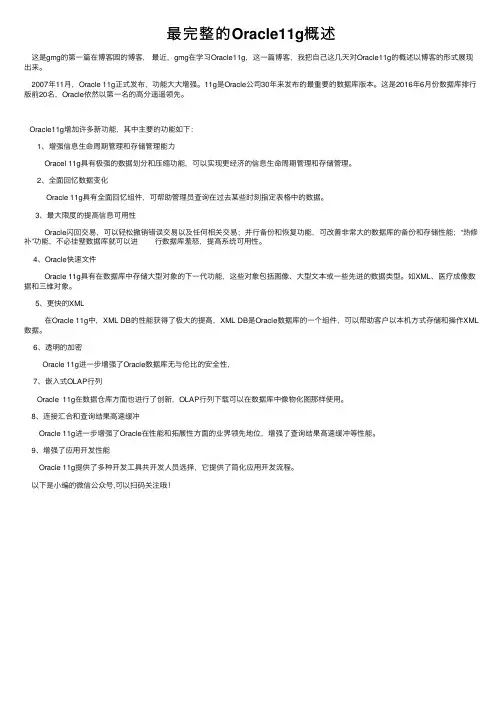
最完整的Oracle11g概述这是gmg的第⼀篇在博客园的博客,最近,gmg在学习Oracle11g,这⼀篇博客,我把⾃⼰这⼏天对Oracle11g的概述以博客的形式展现出来。
2007年11⽉,Oracle 11g正式发布,功能⼤⼤增强。
11g是Oracle公司30年来发布的最重要的数据库版本。
这是2016年6⽉份数据库排⾏版前20名,Oracle依然以第⼀名的⾼分遥遥领先。
Oracle11g增加许多新功能,其中主要的功能如下:1、增强信息⽣命周期管理和存储管理能⼒Oracel 11g具有极强的数据划分和压缩功能,可以实现更经济的信息⽣命周期管理和存储管理。
2、全⾯回忆数据变化Oracle 11g具有全⾯回忆组件,可帮助管理员查询在过去某些时刻指定表格中的数据。
3、最⼤限度的提⾼信息可⽤性Oracle闪回交易,可以轻松撤销错误交易以及任何相关交易;并⾏备份和恢复功能,可改善⾮常⼤的数据库的备份和存储性能;“热修补”功能,不必挂壁数据库就可以进⾏数据库羞怒,提⾼系统可⽤性。
4、Oracle快速⽂件Oracle 11g具有在数据库中存储⼤型对象的下⼀代功能,这些对象包括图像、⼤型⽂本或⼀些先进的数据类型。
如XML、医疗成像数据和三维对象。
5、更快的XML在Oracle 11g中,XML DB的性能获得了极⼤的提⾼,XML DB是Oracle数据库的⼀个组件,可以帮助客户以本机⽅式存储和操作XML 数据。
6、透明的加密Oracle 11g进⼀步增强了Oracle数据库⽆与伦⽐的安全性,7、嵌⼊式OLAP⾏列Oracle 11g在数据仓库⽅⾯也进⾏了创新,OLAP⾏列下载可以在数据库中像物化图那样使⽤。
8、连接汇合和查询结果⾼速缓冲Oracle 11g进⼀步增强了Oracle在性能和拓展性⽅⾯的业界领先地位,增强了查询结果⾼速缓冲等性能。
9、增强了应⽤开发性能Oracle 11g提供了多种开发⼯具共开发⼈员选择,它提供了简化应⽤开发流程。

Oracle Database 11g R1 故障管理故障可诊断性基础结构的目标如下:•预防性地检测问题•检测到问题后,限制损坏和中断•减少问题诊断时间•减少问题解决时间•简化客户与 Oracle 技术支持之间的互动简化诊断:自动诊断工作流通过一个始终处于打开状态的内存中跟踪工具,数据库组件可以在严重错误故障第一次出现时捕获诊断数据。
系统将自动维护一个称为“自动诊断资料档案库”的特殊资料档案库,以保存有关严重错误事件的诊断信息。
此信息可用于创建要发送到 Oracle 支持服务以进行调查的意外事件程序包。
下面是一个可能的诊断会话工作流:1. 意外事件导致 Enterprise Manager (EM) 中出现预警。
2. DBA 可通过 EM 的“Alert(预警)”页查看此预警。
3. DBA 可以细化到意外事件和问题的详细资料。
4. DBA 或 Oracle 支持服务可以决定或要求将信息打包并通过 MetaLink 发送到 Oracle 支持服务。
DBA 可以将文件添加到自动打包的数据中。
自动诊断资料档案库 (ADR)ADR 是一个基于文件的资料档案库,用于存放数据库诊断数据(如跟踪、意外事件转储和程序包、预警日志、健康状况监视器报告、核心转储等)。
它对存储在任何数据库外的多个实例和多种产品使用一个统一的目录结构。
因此,可用于数据库关闭时的问题诊断。
从Oracle Database 11g R1 开始,数据库、自动存储管理 (ASM)、集群就绪服务 (CRS) 和其它Oracle 产品或组件将所有诊断数据都存储在 ADR 中。
每种产品的每个实例都将诊断数据存储在自己的 ADR 主目录下。
例如,在具有共享存储和 ASM 的 Real Application Clusters 环境中,每个数据库实例和每个 ASM 实例在 ADR 中都有一个主目录。
ADR 的统一目录结构对各种产品和实例使用一致的诊断数据格式,而且还有一组统一的工具,使客户和 Oracle 技术支持可以相互关联并分析多个实例的诊断数据。

关闭1.先关数据库:代码如下:[oracle@oeltan1 ~]$ srvctl stop database -d tantest2.再关闭crs服务代码如下:root@oeltan1 ~]# crsctl stop crs启动:代码如下:[root@oeltan1 ~]# crsctl start crs[oracle@oeltan1 ~]$srvctl start asm -n node_name上述开机一般已经启动代码如下:[oracle@oeltan1 ~]$ srvctl start database -d tantest归档设置:1. 分别创建两个实例的asm目录任意一个实例,grid用户下:代码如下:# su - grid[grid@oeltan1 ~]$ sqlplus /as sysasmsql> select name from v$asm_diskgroup;name--------------------------------------------------------------------------------crsdata1fri12 sql> alter diskgroup fri add directory '+fri/tantest'; sql> alter diskgroup fri add directory '+fri/tantest/arch1';还可以通过asmcmd创建目录:123 asmcmd> pwd +fri/tantest asmcmd> mkdir arch22.修改归档参数任意一个实例,oracle用户下:12 alter system set log_archive_dest_1='location=+fri/tantest/arch1' scope=both sid='tantest1'; alter system set log_archive_dest_1='location=+fri/tantest/arch2' scope=both sid='tantest2';3.两个节点上分别都执行:1234 sql> shutdown immediate; sql> startup mount; sql> alter database archivelog; sql> alter database open;--修改一个实例时,另一个实例不能在open状态,否则报ora-01126: database must be mounted in this instance and not open in any4.分别检查:12345678910111213141516 sql> archive log list database log mode archive mode automatic archival enabled archive destination +fri/tantest/arch1 oldest online log sequence 14next log sequence to archive 15 current log sequence 15 sql> archive log list database log mode archive mode automatic archival enabled archive destination +fri/tantest/arch2 oldest online log sequence 6 next log sequence to archive 7 current log sequence 7 sql>更多信息请查看IT技术专栏。
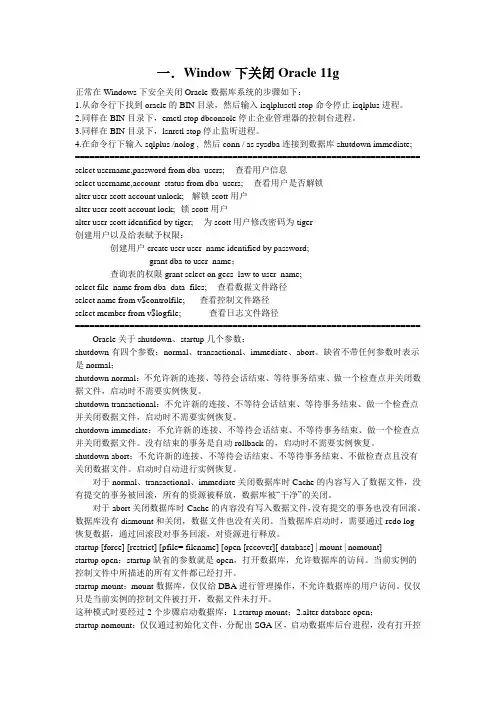
一.Window下关闭Oracle 11g正常在Windows下安全关闭Oracle数据库系统的步骤如下:1.从命令行下找到oracle的BIN目录,然后输入isqlplusctl stop命令停止isqlplus进程。
2.同样在BIN目录下,emctl stop dbconsole停止企业管理器的控制台进程。
3.同样在BIN目录下,lsnrctl stop停止监听进程。
4.在命令行下输入sqlplus /nolog , 然后conn / as sysdba连接到数据库shutdown immediate;====================================================================== select username,password from dba_users; --查看用户信息select username,account_status from dba_users; --查看用户是否解锁alter user scott account unlock; --解锁scott用户alter user scott account lock;--锁scott用户alter user scott identified by tiger; --为scott用户修改密码为tiger创建用户以及给表赋予权限:创建用户create user user_name identified by password;grant dba to user_name;查询表的权限grant select on gecs_law to user_name;select file_name from dba_data_files; --查看数据文件路径select name from v$controlfile; --查看控制文件路径select member from v$logfile; --查看日志文件路径====================================================================== Oracle关于shutdown、startup几个参数:shutdown有四个参数:normal、transactional、immediate、abort。
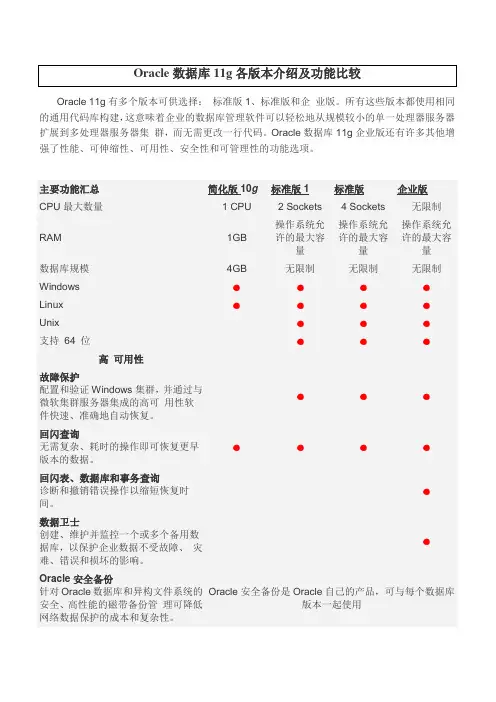
Oracle 11g 有多个版本可供选择: 标准版1、标准版和企 业版。
所有这些版本都使用相同的通用代码库构建,这意味着企业的数据库管理软件可以轻松地从规模较小的单一处理器服务器扩展到多处理器服务器集 群,而无需更改一行代码。
Oracle 数据库11g 企业版还有许多其他增强了性能、可伸缩性、可用性、安全性和可管理性的功能选项。
主要功能汇总 简化版10g标准版1 标准版 企业版CPU 最大数量 1 CPU 2 Sockets 4 Sockets 无限制 RAM 1GB 操作系统允许的最大容量 操作系统允许的最大容量 操作系统允许的最大容量 数据库规模 4GB无限制无限制无限制Windows LinuxUnix支持 64 位高 可用性故障保护配置和验证Windows 集群,并通过与微软集群服务器集成的高可 用性软件快速、准确地自动恢复。
回闪查询无需复杂、耗时的操作即可恢复更早版本的数据。
回闪表、数据库和事务查询诊断和撤销错误操作以缩短恢复时间。
数据卫士创建、维护并监控一个或多个备用数据库,以保护企业数据不受故障、 灾难、错误和损坏的影响。
Oracle 安全备份针对Oracle 数据库和异构文件系统的安全、高性能的磁带备份管 理可降低网络数据保护的成本和复杂性。
Oracle 安全备份是Oracle 自己的产品,可与每个数据库版本一起使用服务器管理的备份和恢复 借助Oracle 恢复管理器(RMAN ) 简化、自动化并提高备份及恢复性能。
可 伸缩性真正 应用集群跨多个相互连接或“集群的”服务器运行任意未做更改的打包或定制的 管理软件。
可选集成的集群件利用一组通用、内置的集群服务创建和运行数据库集群。
自动工作负载管理将服务连接请求发送给拥有最低负载的适当服务器;一旦发生故障,自 动将幸存的服务器重新分配以用于服务。
Java 和PL/SQL 的本地编译用Java 和PL/SQL 语言编写部署在数据库中的程序。
1.1.1企业版数据库软件选型Oracle 数据库11g,和Oracle 数据库10g 版本相比,新增了400 多项功能。
新版数据库经过了1500 万个小时的测试,开发工作量达到了3.6 万人/月,相当于1000 名员工连续研发3 年。
Oracle 数据库11g 新增的重点功能主要有:实时应用测试组件可帮助企业以可控和经济的方法迅速测试并管理IT 环境变化的数据库。
数据卫士组件能同时读取和恢复单个备用数据库,可用于对生产数据库的报告、备份、测试和滚动升级。
新的数据划分功能使很多原来需要手工完成的工作实现了自动化,还扩展了已有的范围、散列和列表划分功能,增加了间隔、索引和虚拟卷划分功能;新的压缩功能可以使所有数据都可以实现2~3 倍或更高的压缩比。
全面回忆组件,可帮助管理员查询在过去某些时刻指定表格中的数据,管理员可以更简便的给数据增加时间维度,以跟踪数据变化、实施审计并满足法规要求。
在保护数据库应用免受计划停机和意外宕机影响方面,新增的Oracle 闪回交易功能可以使管理员撤销错误交易以及任何相关交易;并行备份和恢复功能可改善大数据库的备份和存储性能;“热修补”功能可以在不必关闭数据库的情况下就可以进行数据库修补。
根据Gartner 公司6 月公布的2006 全球关系型数据库市场报告,在全球152 亿美元的市场中,甲骨文的销售额为72 亿美元,市场份额高达47.1%,超过了排名后两位的ibm 和微软的总和。
报告还表明,Oracle 数据库的平台以Unix 和Linux 为主,微软则是Windows 平台,IBM 数据库则以z 系列服务器平台为重点。
而Oracle 11g 版本则增强了对微软平台的支持,为开发在Oracle 平台上运行的.NET 应用,实现了与Visual Studio 2005 的本机集成。
1.1.1.111g新特性概述由于数据库大小每两年就会增加2 倍,IT 部门正面临着新的和熟悉的挑战:如何在服务器、存储器或站点出现故障时保持用户的服务水平?如何防止数据泄露并确保合规性?如何存储、管理和保护所有类型的信息,并将其轻松集成到日常业务操作中?如何伸缩大型事务处理和数据仓库系统并确保性能、可靠性和可管理性?如何升级软件和硬件,同时尽量降低更改的风险?Oracle 利用Oracle 数据库11 g 中的大量新特性和增强功能帮助您解决了这些挑战。
安装Oracle前linux系统参数的配置检查下列包是否安装,如果未安装则要先安装。
# rpm -qa | grep make gcc glibc 等等binutils-2.17.50.0.6-2.el5compat-libstdc++-33-3.2.3-61elfutils-libelf-0.125-3.el5elfutils-libelf-devel-0.125glibc-2.5-12glibc-common-2.5-12glibc-devel-2.5-12gcc-4.1.1-52gcc-c++-4.1.1-52libaio-0.3.106libaio-devel-0.3.106libgcc-4.1.1-52libstdc++-4.1.1libstdc++-devel-4.1.1-52.e15make-3.81-1.1sysstat-7.0.0unixODBC-2.2.11unixODBC-devel-2.2.11在安装Oracle 11g前,先关闭系统防火墙,禁用selinux;需要手工更改系统的内核参数以及创建oracle用户和用户组,具体操作步骤如下所述。
(1)创建oracle用户和oinstall、dba用户组命令如下所示。
# /usr/sbin/groupadd oinstall //创建用户组oinstall# /usr/sbin/groupadd dba //创建用户组dba# /usr/sbin/useradd -m -g oinstall -G dba oracle //创建用户oracle# id oracle //查看用户oracle的属性uid=512(oracle) gid=1005(oinstall) groups=1005(oinstall),1006(dba)(2)设置oracle用户的口令,命令如下所示。
# passwd oracle //设置oracle用户的口令Changing password for user oracle.New UNIX password:BAD PASSWORD: it is too simplistic/systematicRetype new UNIX password:passwd: all authentication tokens updated successfully.//口令更改成功(3)创建Oracle的安装目录。
Oracle 11g日常操作与维护手册拟制:数据库TMG 日期:20011-2-14 审核:日期:批准:日期:目录第1章文档说明 (5)第2章CRS的管理 (5)2.1 RAC状态检查 (5)2.1.1检查守护进程状态 (5)2.1.2检查资源状态 (5)2.2 手工启动与关闭RAC (6)2.3 OCR的管理 (6)2.4 VOTING DISK的管理 (8)2.5 CSS管理 (9)2.6 管理工具SRVCTL (9)2.6.1管理实例 (9)2.6.2管理监听程序 (9)2.6.3管理ASM (10)2.6.4管理service (10)2.7 修改RAC的IP及VIP (11)2.7.1修改外网IP及心跳IP (11)2.7.2修改VIP (11)2.7.3查看与删除IP (12)第3章ASM的管理 (13)3.1 管理DG (13)3.1.1建立与扩充disk group (13)3.1.2 mount与unmount的命令 (14)3.1.3删除disk group (14)3.1.4增加DISK的total_mb (14)3.1.5 DG的属性-AU大小 (14)3.1.6 DG的属性-离线删除时间 (15)3.1.7 DG的属性-兼容版本 (15)3.1.8向ASM中添加disk的完整步骤 (16)3.2 ASMCMD (17)3.2.1 ASMCMD常用命令 (17)3.2.2复制ASM文件 (18)3.2.3命令lsdg (18)3.2.4元数据备份与恢复 (18)3.3 ASM磁盘头信息备份与恢复 (19)3.4 ASM常用视图 (20)3.4.1视图V$ASM_DISKGROUP (20)3.4.2视图V$ASM_DISK (21)3.5 常用方法 (22)3.5.1如何确定ASM实例的编号 (22)3.5.2查询DG-RAW-磁盘的对应关系 (22)第4章数据库管理 (24)4.1 参数文件管理 (24)4.2 表空间管理 (25)4.2.1表空间自动扩张 (25)4.2.2表空间更名 (26)4.2.3表空间的数据文件更名 (26)4.2.4缺省表空间 (26)4.2.5表空间删除 (27)4.2.6 UNDO表空间 (27)4.2.7 TEMP表空间 (27)4.3 重做日志文件管理 (27)4.3.1增加REDO日志组 (27)4.3.2删除日志组 (28)4.3.3日志切换 (28)4.3.4日志清理 (28)4.3.5重做日志切换次数查询 (28)4.4 归档模式 (29)4.4.1单实例数据库修改为归档模式的方法 (29)4.4.2 RAC数据库修改为归档模式的方法 (29)4.4.3归档路径 (30)4.5 重建控制文件 (31)4.6 内存参数管理 (32)4.6.1 Oracle内存管理发展阶段 (32)4.6.2自动内存管理AMM (32)4.6.3自动共享内存管理ASMM (33)4.6.4自动PGA管理 (33)4.7 其他管理内容 (33)4.7.1数据库版本查看 (33)4.7.2字符集 (34)4.7.3创建密码文件 (34)4.7.4关闭审计功能 (34)4.7.5帐号管理 (34)4.7.6 profile管理 (35)第1章文档说明本文档描述了Oracle11g中常见的维护和管理方法,包括CRS、ASM、数据库等。
Oracle11g数据库产品简介介绍Oracle数据库11g家族,是一个对不同级别的业务,不同规模的组织都有量身定做产品,对不同IT需求都有解决方案的家族。
Oracle也提供数据库选件产品来加强Oracle数据库11g某些特殊的应用需求。
本文将概要的介绍这些功能和选件。
Oracle数据库11g企业版(EE)提供了有效,可靠,安全的数据管理功能以应对关键的企业业务和在线事务处理应用,复杂查询的数据仓库或者WEB2.0应用。
企业版就没有SOCKET限制,单机或者集群都可以使用使用高级选件满足特殊需求、Oracle数据库11g产品具有丰富的功能以满足当代业务需求。
此外,Oracle还提供了一系列企业版选件来满足贵公司某些特殊需求,比如确保关键业务可靠性,数据仓库等复杂需求。
活动数据卫士选件(Actvie Data Guard)Oracle活动数据卫士——一个Oracle数据库11g企业版选件——通过将负载压力从仅一个生产数据库上分担到一个或者多个容灾数据库的方式,加强了数据库对外服务的质量。
Oracle活动数据卫士增强了对物理备用数据库只读访问处理能力,让其可以很好的用来查询,排序,出报表,支持网页访问…同时还可以接受来自主点数据库传输过来的数据变更日志。
Oracle活动数据卫士也支持备用数据库的快速增量备份。
这可以提供更好的高可靠性能和容灾保护以应对计划停机和非计划停机。
高级压缩选件(Advanced Compression)Oracle数据库11g企业版的高级压缩选件帮助你管理不断增长的数据(数据量一般每2年就会增长3倍)。
Oracle高级压缩选件可以压缩不同的数据,无论是结构化数据,还是像文件,图片这样的非结构化数据,甚至是网络传输的备份数据都可以很好的压缩。
如此一来你就可以充分的利用资源,减少在存储上面的开支。
高级安全选件(Advanced Security)Oracle高级安全选件提供透明数据加密,可以对数据库里存储的数据和网络传输的数据进行加密。
Oracle 11g必须开启的服务及服务详细介绍
成功安装Oracle 11g数据库后,你会发现自己电脑运行速度会变慢,配置较低的电脑甚至出现非常卡的状况,通过禁止非必须开启的Oracle服务可以提升电脑的运行速度。
那么,具体该怎么做呢?
按照win7 32/64位环境下Oracle 11g R2安装详解中的方法成功安装Oracle 11g后,共有7个服务,分别为Oracle ORCL VSS Writer Service,OracleDBConsoleorcl,OracleJobSchedulerORCL,
OracleMTSRecoveryService,OracleOraDb11g_home1ClrAgent,OracleOraDb11g_home1TNSListener,OracleServiceORCL。
其中OracleDBConsoleorcl,
OracleMTSRecoveryService,OracleOraDb11g_home1TNSListener,OracleServiceORCL是默认自动启动的,OracleJobSchedulerORCL是默认自动禁止的,其余的默认为手动操作。
假设您的全局数据库名为orcl,则您的Oracle服务应该和上面的一样。
如下图所示:
这七个服务的含义分别为:
Oracle ORCL VSS Writer Service:Oracle卷映射拷贝写入服务,
VSS(Volume Shadow Copy Service)能够让存储基础设备(比如磁盘,阵列等)
创建高保真的时间点映像,即映射拷贝(shadow copy)。
它可以在多卷或者单个卷上创建映射拷贝,同时不会影响到系统的系统能。
(非必须启动)
OracleDBConsoleorcl:Oracle数据库控制台服务,orcl是Oracle的实例标识,默认的实例为orcl。
在运行Enterprise Manager(企业管理器OEM)的时候,需要启动这个服务。
(非必须启动)
OracleJobSchedulerORCL:Oracle作业调度(定时器)服务,ORCL是Oracle 实例标识。
(非必须启动)
OracleMTSRecoveryService:服务端控制。
该服务允许数据库充当一个微软事务服务器MTS、COM/COM+对象和分布式环境下的事务的资源管理器。
(非必须启动)
OracleOraDb11g_home1ClrAgent:Oracle数据库.NET扩展服务的一部分。
(非必须启动)
OracleOraDb11g_home1TNSListener:监听器服务,服务只有在数据库需要远程访问的时候才需要。
(非必须启动,下面会有详细详解)。
OracleServiceORCL:数据库服务(数据库实例),是Oracle核心服务该服务,是数据库启动的基础,只有该服务启动,Oracle数据库才能正常启动。
(必须启动) 那么在开发的时候到底需要启动哪些服务呢?
对新手来说,要是只用Oracle自带的sql*plus的话,只要启动OracleServiceORCL即可,要是使用PL/SQL Developer等第三方工具的话,OracleOraDb11g_home1TNSListener服务也要开启。
OracleDBConsoleorcl 是进入基于web的EM必须开启的,其余服务很少用。
注:ORCL是数据库实例名,默认的数据库是ORCL,你可以创建其他的,即OracleService+数据库名。